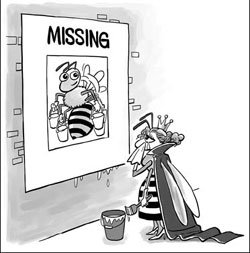The ominous disappearance of not birds but bees
By May R. Berenbaum (China Daily)Updated: 2007-03-06 07:14
When Hollywood filmmakers want to heighten the tension of an insect fear film, they just arrange for millions of killer bees to appear out of nowhere to threaten a vulnerable group of people .
But people from all demographic groups across the country are facing a much more frightening real-life situation: the disappearance of millions of bees.
This winter, in more than 20 states, beekeepers have noticed that their honeybees have mysteriously vanished, leaving behind no clues as to their whereabouts. There are no telltale dead bodies either inside colonies or out in front of hives, where bees typically deposit corpses of dead nestmates.
What's more, the afflicted colonies tend to be full of honey, pollen and larvae, as if all of the workers in the nest precipitously decamped on some prearranged signal.
Beekeepers are up in arms last month, leaders in the business met with research scientists and government officials in Florida to figure out why the bees are disappearing and how to stop the losses. Nobody had any answers.
That beekeepers are alarmed over this situation is understandable, but, just as in the movies, the public may not recognize the magnitude of the threat that these mysterious events present.
A decline in the numbers of Apis melllifera, the world's
most widely distributed semi-domesticated insect, doesn't just mean a shortage
of honey for toast and tea. 
In fact, the economic value of honey, wax and other bee products is trivial in comparison with the honeybee's services as a pollinator.
More than 90 crops in North America rely on honeybees to transport pollen from flower to flower, effecting fertilization and allowing production of fruit and seed. The amazing versatility of the species is worth an estimated $14 billion a year to the United States economy.
Approximately one-third of the typical American's diet (primarily the healthiest part) is directly or indirectly the result of honeybee pollination. Production of almonds in California, a $2 billion enterprise, is almost entirely dependent on honeybees.
Theories abound as to potential causes of what is being called colony collapse disorder. As a social species living in close quarters at high densities the average hive contains upwards of 30,000 insects honeybees are prone to a staggering diversity of fungal, bacterial and viral diseases.
In the 1980s, honeybee numbers plummeted when two species of parasitic mites appeared, wiping out most populations of wild bees and placing more pressure on managed colonies. This latest drop in numbers may be the consequence of a new infection, or of several diseases simultaneously, leading to a fatally compromised immune system.
It is also possible that severe stress brought on by crowding, inadequate nutrition or even the combined effects of prophylactic antibiotics and miticides sprayed by beekeepers to ward off infections may be a factor.
Another, particularly sad, possibility is that accidental exposure to a new pesticide may cause non-lethal behavioral changes that interfere with the ability of honeybees to orient and navigate; brain-damaged foraging bees may simply get lost on their way home and starve to death away from the hive.
Irrespective of its causes, however, this drop comes at a critical time, with demand for pollination services rocketing upward.
The New York Times
(China Daily 03/06/2007 page10)
|
|
|
|